Key takeaways:
- Cannabis training techniques, such as low-stress training (LST), topping, and super cropping, enhance plant growth and maximize yields through better light exposure and airflow.
- Training fosters a deeper connection between growers and plants, emphasizing patience and respect for the plant’s resilience.
- Consistent observation and adaptability are crucial for successful training, helping growers respond effectively to challenges and optimize results.
- Collaboration and seeking support from fellow growers can provide valuable insights and solutions, enriching the training experience.

Understanding cannabis training techniques
Cannabis training techniques are essential for optimizing plant growth and maximizing yields. I remember the first time I tried low-stress training (LST) on my plants; it felt like I was sculpting them into beautiful forms. By gently bending and tying down branches, I realized I could create a more even canopy, allowing light to reach all parts of the plant effectively.
One of the most fascinating aspects of these techniques is understanding how each method influences growth. For example, topping to encourage bushier plants made me appreciate how a simple cut could lead to a more productive harvest. Have you ever thought about how much control we have over the plant’s trajectory? With techniques like Screen of Green (ScrOg), I found that by using a net to hold branches down, I could guide them in a way that maximized light exposure and airflow, which is crucial for plant health.
Every training method offers a unique opportunity to engage with your plants in a more hands-on way. For instance, with super cropping, it was both thrilling and nerve-wracking to pinch and bend the stems. The emotional investment I felt during that process taught me patience and respect for the plant’s resilience. It made me wonder, how often do we overlook the art of training when cultivating cannabis? This deep connection with the plants enhances not only the gardening experience but also the understanding of their growth patterns.
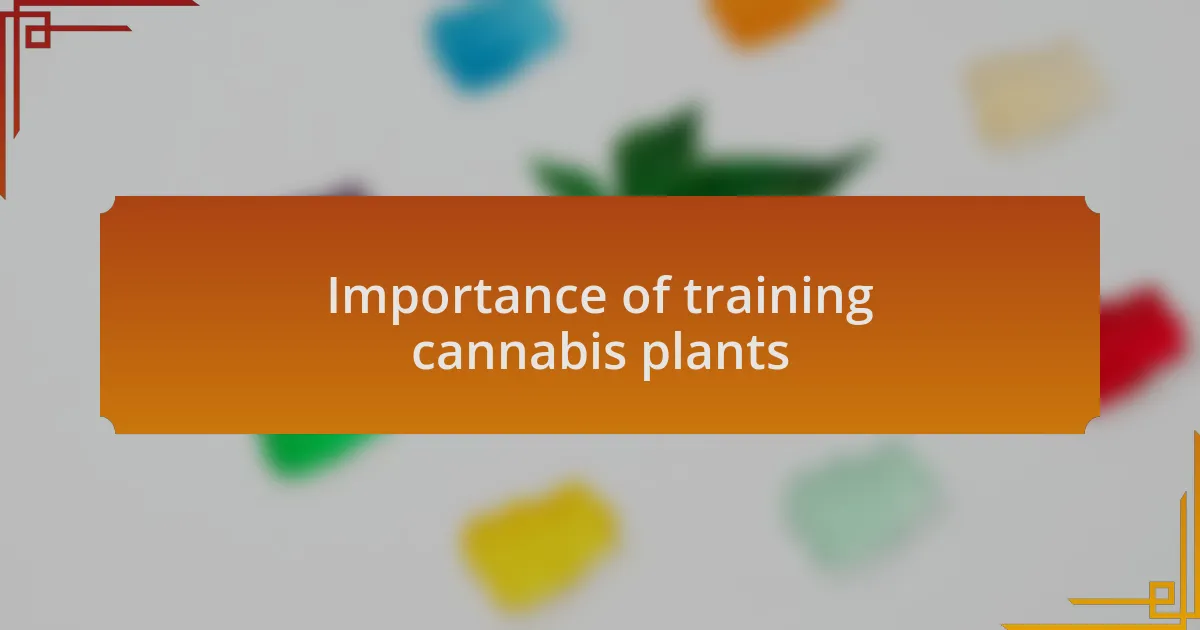
Importance of training cannabis plants
Training cannabis plants is not just about enhancing yields; it also fosters a deeper connection with the cultivation process. I recall a time when I utilized defoliation, a training method that involves removing leaves to improve light penetration. Initially hesitant, I found it enlightening to see how my plants responded; a new layer of growth emerged as if they were thanking me for allowing them to breathe. Could there be a more rewarding experience than witnessing this transformation?
Moreover, training techniques play a significant role in managing plant health and preventing issues like mold or pests. I once had a crop that was unfortunately susceptible to powdery mildew. It wasn’t until I implemented a comprehensive training approach, focusing on airflow and exposure, that I noticed a marked improvement. Have you considered how such strategies not only improve yield but also reduce the risk of such challenges?
The ability to manipulate a plant’s structure allows growers to optimize their environment consciously. I remember my early days, wrestling with a tall, unruly plant that seemed to stretch toward the ceiling. By employing techniques like LST, I turned that challenge into an opportunity, guiding my plants to maximize available space. Isn’t it fascinating how training can shift our perspective from frustration to empowerment in gardening?
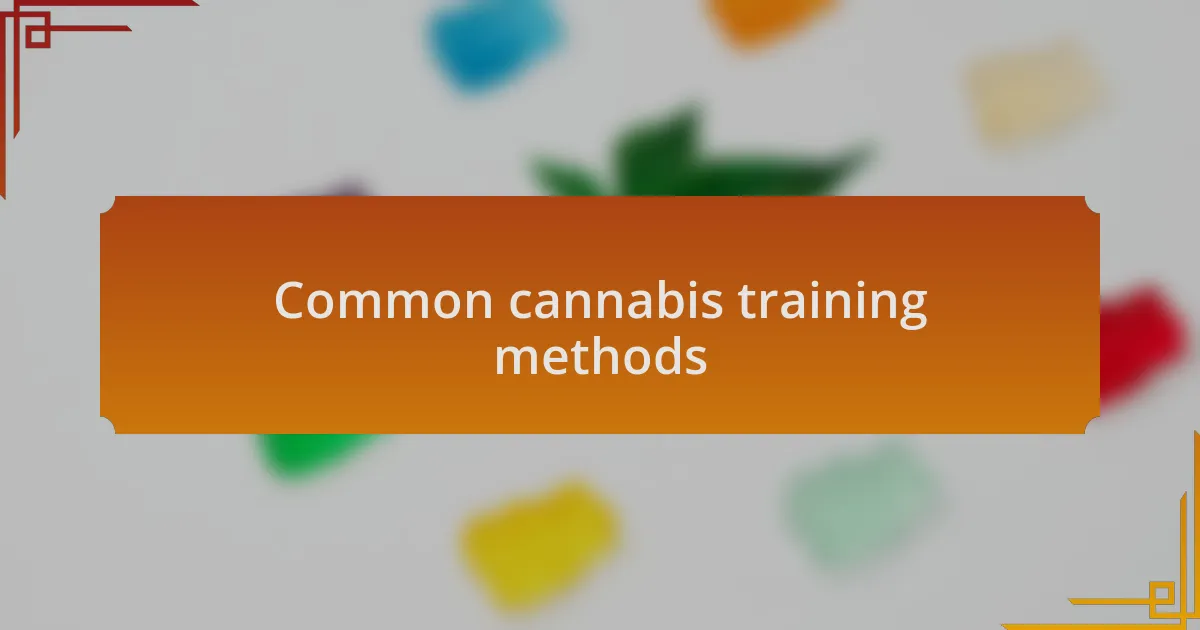
Common cannabis training methods
Training cannabis plants can take several forms, each with its own benefits and techniques. One of my personal favorites is the Screen of Green (SCROG) method, where I used a mesh screen to force my plants to grow horizontally. This experience was eye-opening; I remember feeling a surge of excitement as I watched the buds develop evenly across the screen, maximizing light exposure. Have you tried manipulating the plant’s growth in such a strategic way?
Another effective technique is topping, which involves cutting off the top of the main stem to promote bushier growth. I recall the first time I topped a plant, it felt a bit daunting to make that cut. But the result was rewarding — a lush, fuller plant that yielded more than I anticipated. It got me thinking: what risks are you willing to take for greater rewards in your garden?
Lastly, High-stress training (HST) can yield exceptional results by intentionally stressing the plant to encourage more significant growth. I remember using this method when I was trying to encourage my plants to branch out more. The adrenaline rush of bending and twisting the branches was thrilling. It made me appreciate the resilience of these plants and how they can thrive under pressure. Isn’t it fascinating how training methods can reveal the untapped potential within each cannabis plant?
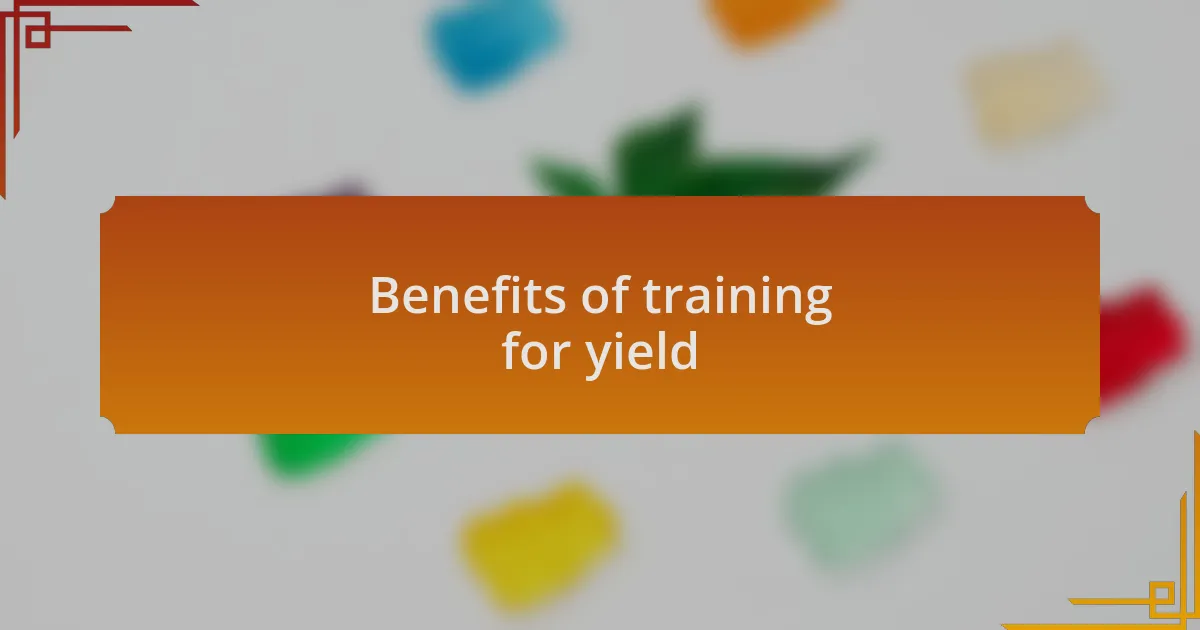
Benefits of training for yield
Training cannabis plants for increased yield comes with a host of benefits that are hard to ignore. I remember the first time I incorporated low-stress training (LST) into my gardening routine. Watching the branches spread out and catch more light felt almost magical, and it translated directly into denser, more resinous buds. Have you ever experienced that moment of realization when your efforts yield surprising results?
Beyond just aesthetics, training can significantly enhance airflow and light penetration within the canopy. This was particularly evident when I used the bend-and-tie method. I saw how much healthier the plants became, all while minimizing the risk of mold. It’s amazing how a little adjustment can create such a positive ripple effect, don’t you think?
I’ve also found that training cultivates a deeper connection with the plant. As I would spend time shaping and guiding its growth, I felt more invested in the process. It became less about just getting a higher yield and more about nurturing the plant’s potential. That relationship really elevates the entire experience, wouldn’t you say?
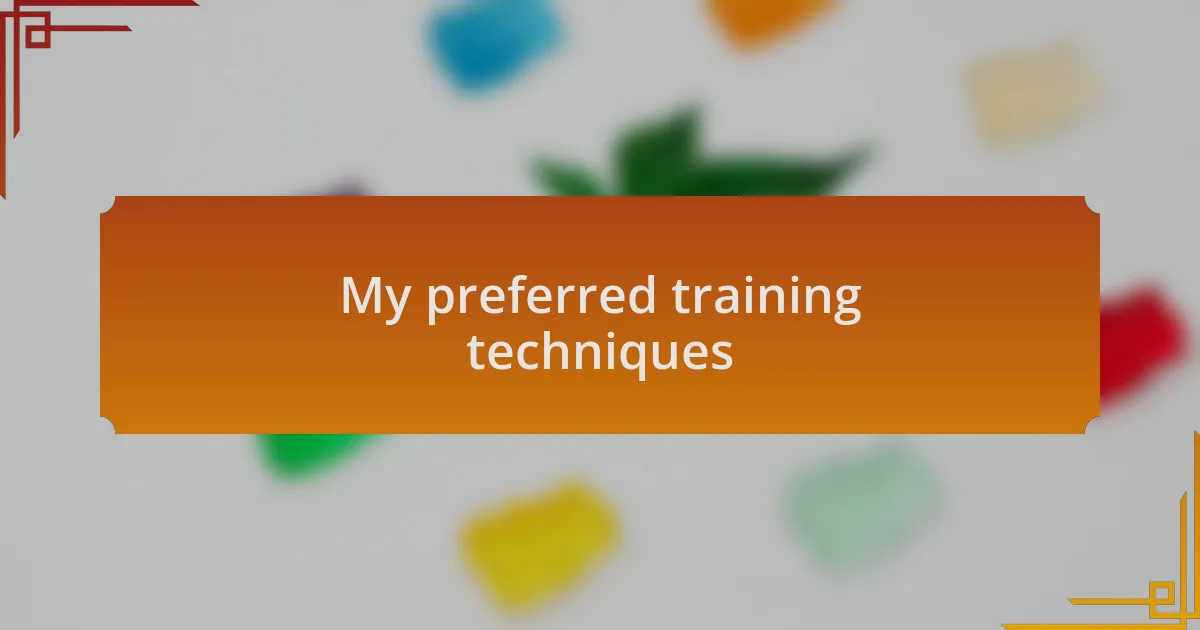
My preferred training techniques
When it comes to my preferred training techniques, I’m a huge advocate for low-stress training (LST). I vividly remember the first time I tied down a branch. It felt counterintuitive to me at first, but witnessing how that simple bend allowed sunlight to flood the lower growth was a game changer. The thrill I felt as those newly exposed buds began to thrive was an unforgettable moment. Have you ever tried bending a branch just to watch it flourish?
Another technique I often lean towards is topping, which involves cutting off the top of the main stem to promote more lateral growth. The first time I topped a plant, I was amazed at how quickly it responded by sending out multiple new shoots. It’s a perfect example of how cannabis can adapt and thrive under guidance. Don’t you find it fascinating how plants can respond so dynamically to our interventions?
I also cherish the practice of super cropping, where I gently crush the stems to promote healing and growth. The first time I tried it, I felt apprehensive, almost like I was intentionally harming my plant. Yet, seeing it strengthen and grow back even more robust inspired me deeply. It’s a reminder that growth sometimes requires a little pressure—just like in our own lives, right?
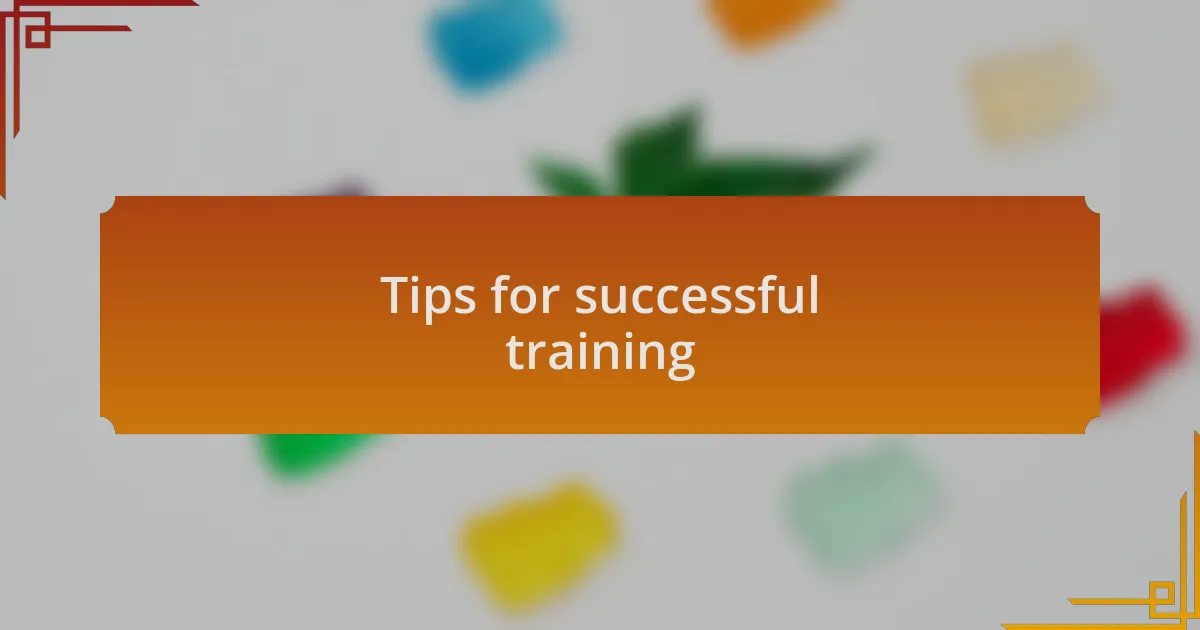
Tips for successful training
When approaching training techniques, consistency is key. I remember a time when I got a little too eager, skipping days between sessions, and the plants didn’t respond as well as I hoped. Sticking to a routine not only sets expectations for the plants but also helps me stay connected to their progress—isn’t it amazing how structure can yield such strong results?
Another important tip is to observe your plants closely. I find that spending time with them allows me to notice subtle changes or signs that my training methods are working or need adjustment. It’s like having a conversation; the more you pay attention, the better you understand their needs. Have you ever really watched your plants? The differences in their growth can tell you so much.
Finally, patience is essential in training. I recall a moment when I rushed a technique and ended up stunting growth rather than enhancing it. This taught me that good results take time. It’s tempting to want everything to flourish immediately, but just like any relationship, nurturing growth requires time and care. Have you ever had to remind yourself to slow down and let nature take its course?
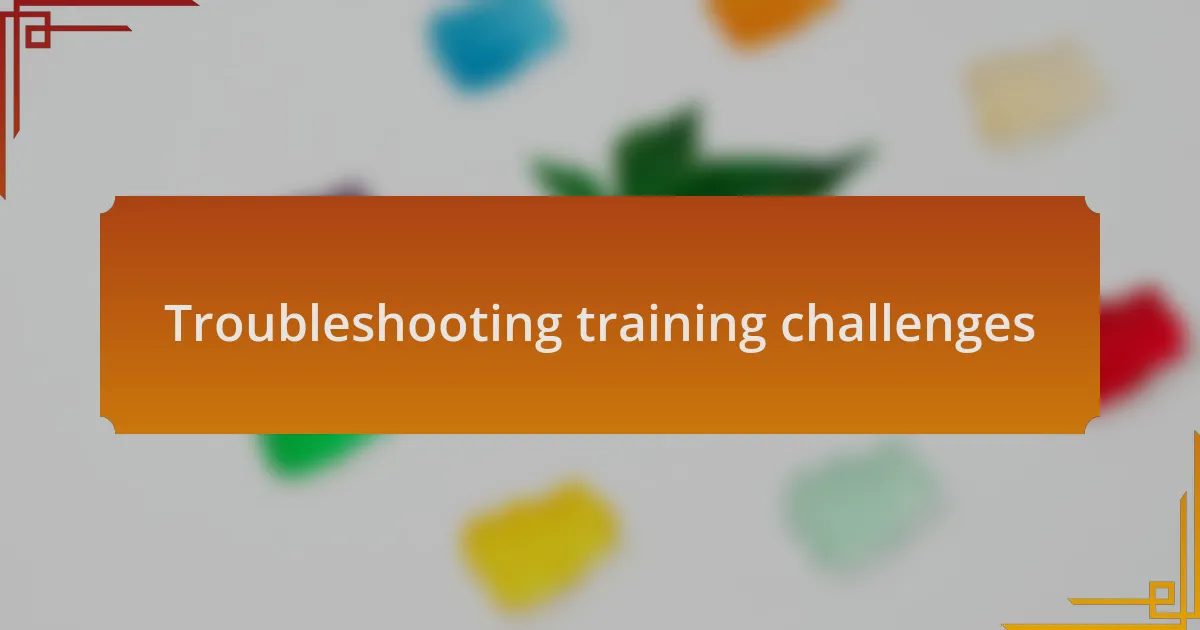
Troubleshooting training challenges
When troubleshooting training challenges, it’s vital to be adaptable. I once faced a situation where my plants seemed to be resisting a certain training technique, and it threw me off balance. I realized then that flexibility is crucial; sometimes, a method that works for one strain may not suit another. Have you ever felt stuck, unsure of how to proceed? That’s the moment when being open to change can truly save the day.
Another aspect to consider is the environment in which the plants grow. I remember when I underestimated how fluctuations in temperature affected my training results. Those unexpected shifts taught me to monitor my grow space closely; it’s incredible how a few degrees can change everything. Have you ever thought about how your environment influences plant behavior? Recognizing these external factors has helped me refine my approach significantly.
Lastly, never hesitate to seek support. I’ve had moments where bouncing ideas off fellow growers provided insights I hadn’t considered. Sometimes, it’s just a fresh perspective that brings clarity. Have you tried collaborating with others? I’ve found that engaging in discussions can reveal solutions to challenges that seemed insurmountable, making the training journey much more enriching.